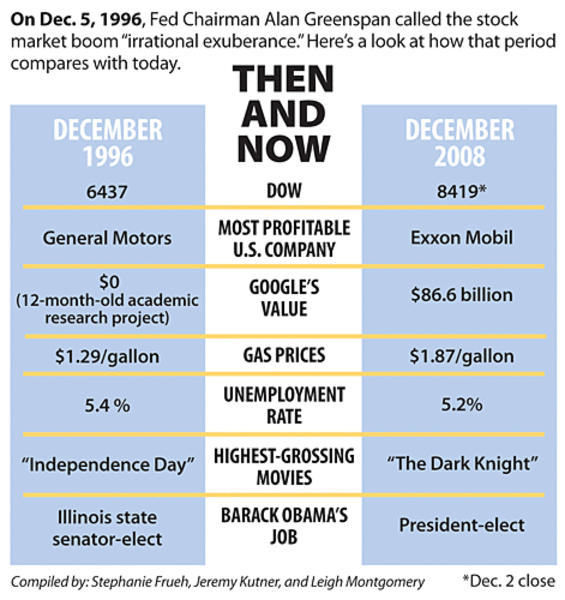Is US now stuck with irrational pessimism?
| New York
Twelve years ago tomorrow, Federal Reserve Board chairman Alan Greenspan famously chalked up the boom in stock markets to "irrational exuberance."
Now, with the US stuck in one of the worst bear markets in postwar history, the opposite seems to be true. Since Sept. 15, the Dow Jones Industrial Average has closed down more than 500 points on seven separate occasions. Two weeks ago, the averages were down nearly half from their peak. Brokers report thousands of Americans are closing their accounts, fed up with a market that has made their 401(k) accounts look like 201(k)s.
So is this the era of irrational pessimism? It's a hard question because there are so many uncertainties surrounding the future direction of the economy and consequently the direction of corporate earnings. If the economy spirals down next year, today's stock prices may look reasonable. If the economy's landing is softer, perhaps the pessimism is overdone.
"No doubt there is a lot of pessimism," says Fred Dickson, chief market strategist at D.A. Davidson & Co. in Lake Oswego, Ore. "The jury is still out if it's irrational."
One thing is clear: It's the era of uncertainty.
Take the economy, for example. Economists expect it will still be in recession in the first half of next year. But they're unsure if that will still be true in the second half.
"We're getting a better feel for the shape of the economy, but it's still not very good," says Mr. Dickson.
Key question mark: layoffs
One of the big unknowns: How high will the unemployment rate climb?
On Friday, the Labor Department will release the jobs numbers for November. The consensus forecast is for a loss of about 325,000 jobs and an unemployment rate of 6.8 percent. But future months will be much worse, say some forecasters. "There could be horrible job losses in the next two months," says Charles Knott, founder of Knott Capital in Exton, Pa.
Big job losses, he notes, can become dangerous to the economy as they lead to a "vicious circle," where companies see demand fall and then have to lay off more workers. An example of the pessimism: predictions for a double-digit unemployment rate. He doubts it will get that bad but says he will be watching the weekly new unemployment claims data. Currently, claims are running at an average of 518,000 over the last four weeks.
"If it gets up to 580,000 or 600,000 per week, it would show me there is too much momentum there and we need more stimulus," says Mr. Knott.
The current situation stands in sharp contrast to 1996, when Mr. Greenspan uttered his "irrational exuberance" line.
Back then, few economists had any doubt about the direction of the economy – it was going to grow. Investors were clambering for shares of technology stocks. The dollar was strong. The future looked rosy.
"Everyone was on the train to happy land," recalls John Lekas, a portfolio manager at Leader Capital Management in Portland, Ore. "Greenspan was saying you might want to get off at the next stop – he was right about that."
One sign of the difference in investment psychology: Wall Street in 1996 was busy raising money for fiber-optic links around the world. This would later lead to a rush of initial public offerings and eventually the growth of companies such as Enron and Global Crossing. Both eventually failed in the dot.com collapse five years later.
This past September, by contrast, saw no new public stock offerings. In October, there was only one. "Essentially, investment banking has dried up in the last 90 days," says Dickson.
Part of this pessimism is related to a "negative feedback loop" that the nation has entered, says economist Richard DeKaser of National City, a Cleveland bank. When the loop is present, investors, business people and many ordinary workers are expecting the worst.
For example, today's low interest rates could be viewed as a potential stimulus to the economy. But some investors think the US has entered a liquidity trap, he says, where low interest rates don't do anything to help the economy – much like Japan in the 1990s.
"I don't agree," he adds, "but when you are in that moment, you are susceptible to feedback loops."
It's an old story – trying to stay out of the way of trampling herds. In 1841, Charles Mackay wrote "Extraordinary Popular Delusions and the Madness of Crowds," a book that detailed 200 years' worth of investment bubbles and schemes.
The stories told by Mr. Mackay "sound like only yesterday, or maybe even today," wrote Peter Bernstein, a financial author and guru, in a forward to a 1996 reprinting of the book.
Will pessimism lead to rebound?
Some investors believe today's extreme pessimism may contain the seeds for recovery – at least in the stock market. "Assume there are 20 people on a deserted island and 19 have sold whatever they have to one person," says Mr. Lekas. "I would think most of the sellers are out of the way." He predicts a massive stock market rally at year's end.
Others aren't so sure. They argue that the pessimism might be warranted.
"We really do have a serious systemic risk and the problem is not irrational," maintains Andre Weisbrod, a Pittsburgh-based financial planner and mutual-fund portfolio manager. "I'm not in a hurry to dive back in even though some companies are screaming 'Buy me, buy me.' "





